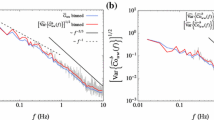Abstract
We formulate a method for determining the smallest time interval Δ Tover which a turbulence time series can be averaged to decompose it intoinstantaneous mean and random components. From the random part the method defines the optimal interval (or averaging window) AW over which this part should be averaged to obtain the instantaneous spectrum. Both Δ T and AW vary randomly with time and depend on physical properties of the turbulence. Δ T also depends on the accuracy of the measurements and is thus independent of AW. Interesting features of the method are its real-time capability and the non-equality between AW and Δ T.
Similar content being viewed by others
References
Andreas, E. L.: 1988, ‘Estimating Averaging Times for Point and Path-Averaged Measurements of Turbulence Spectra’, J. Appl. Meteorol. 27, 295–304.
Andreas, E. L. and Treviño, G.: 1997, ‘Using Wavelets to Detect Trends’, J. Atmos. Oceanic Tech. 14, 554–564.
Andreas, E. L., Hill, R. J., Gosz, J. R., Moore, D. I., Otto, W. D., and Sarma, A. D.: 1998, ‘Statistics of Surface-Layer Turbulence over Terrain with Metre-Scale Heterogeneity’, Boundary-Layer Meteorol. 86, 379–408.
Bendat, J. S. and Piersol, A. G.: 1971, Random Data: Analysis and Measurement Procedures, Wiley-Interscience, New York, 407 pp.
Blackwelder, R. F. and Kaplan, R. E.: 1976, ‘On the Wall Structure of the Turbulent Boundary Layer’, J. Fluid Mech. 76, 89–113.
Bradshaw, P.: 1971, An Introduction to Turbulence and Its Measurement, Pergamon Press, Oxford, U.K., 218 pp.
Cohen, L.: 1995, Time-Frequency Analysis, Prentice-Hall, New Jersey, 299 pp.
Gluhovsky, A. and Agee, E.: 1994, ‘A Definitive Approach to Turbulence Statistical Studies in Planetary Boundary Layers’, J. Atmos. Sci. 51, 1682–1690.
Gupta, A. K.: 1996, ‘Short-Time Averaging of Turbulent Shear Flow Signals’, in G. Treviño, J. C. Hardin, B. Douglas, and E. L. Andreas (eds.), Current Topics in Nonstationary Analysis, World Scientific, Singapore. pp. 159–173.
Gupta, A. K., Laufer, J., and Kaplan, R. E.: 1971, ‘Spatial Structure in the Viscous Sublayer’, J. Fluid Mech. 50, 493–513.
Henjes, K.: 1997, ‘Isotropic and Anisotropic Correlations in Turbulent Wind Speed Data’, Boundary-Layer Meteorol. 84, 149–167.
Holman, R. E. and Hart, G. C.: 1972, ‘Structural Response to Segmented Nonstationary Random Excitation’, AIAA Journal 10, 1473–1478.
Jones, D. L. and Parks, T. W.: 1990, ‘A High Resolution Data-Adaptive Time-Frequency Representation’, IEEE Trans. Acous., Speech Signal Proc. 38, 2127–2135.
Kaimal, J. C., Clifford, S. F., and Lataitis, R. J.: 1989, ‘Effect of Finite Sampling on Atmospheric Spectra’, Boundary-Layer Meteorol. 47, 337–347.
Lenschow, D. H., Mann, J., and Kristensen, L.: 1994, ‘How Long Is Long Enough When Measuring Fluxes and Other Turbulence Statistics?’, J. Atmos. Oceanic Tech. 11, 661–673.
Lumley, J. L. and Panofsky, H. A.: 1964, The Structure of Atmospheric Turbulence, Interscience Publishers, New York, 239 pp.
Papoulis, A.: 1965, Probability, Random Variables, and Stochastic Processes, McGraw-Hill, New York, 583 pp.
Sreenivasan, K. R., Chambers, A. J., and Antonia, R. A.: 1978, ‘Accuracy of Moments of Velocity and Scalar Fluctuations in the Atmospheric Surface Layer’, Boundary-Layer Meteorol. 14, 341–359.
Treviño, G.: 1982, ‘The Frequency Spectrum of Nonstationary Random Processes’, in O. D. Anderson (ed.), Time Series Analysis: Theory and Practice 2, North-Holland, pp. 237–246.
Treviño, G.: 1985, ‘A Method for Approximating the Mean-Value of Nonstationary Random Data’, in O. D. Anderson (ed.), Time Series Analysis: Theory and Practice 7, North-Holland, pp. 465–473.
Wyngaard, J. C.: 1973, ‘On Surface-Layer Turbulence’, in D. A. Haugen (ed.), Workshop on Micrometeorology, American Meteorological Society, Boston, pp. 101–149.
Wyngaard, J. C. and Clifford, S. F.: 1978, ‘Estimating Momentum, Heat and Moisture Fluxes from Structure Parameters’, J. Atmos. Sci. 35, 1204–1211.
Author information
Authors and Affiliations
Rights and permissions
About this article
Cite this article
Treviño, G., Andreas, E.L. Averaging Intervals For Spectral Analysis Of Nonstationary Turbulence. Boundary-Layer Meteorology 95, 231–247 (2000). https://doi.org/10.1023/A:1002632004254
Issue Date:
DOI: https://doi.org/10.1023/A:1002632004254




